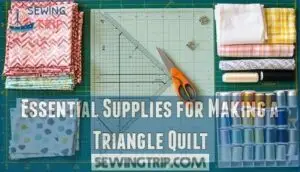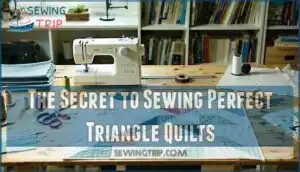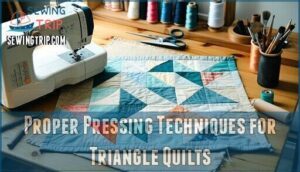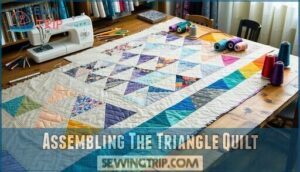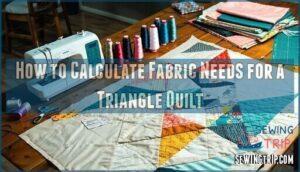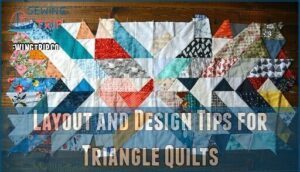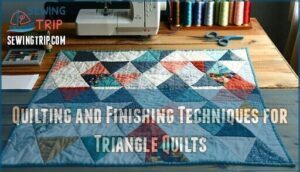This site is supported by our readers. We may earn a commission, at no cost to you, if you purchase through links.

Start with a 60-degree triangle ruler for accurate shapes. Pin triangles right sides together, matching raw edges perfectly.
Sew with a consistent ¼-inch seam allowance, using your presser foot as a guide. Press seams toward the darker fabric to prevent show-through.
Chain piecing saves time when joining multiple triangles. Keep your iron handy—proper pressing makes all the difference between amateur and professional-looking results.
Most quilters struggle with one essential step that can make or break their triangle points.
Table Of Contents
- Key Takeaways
- Cutting 60 Degree Triangles
- Sewing Triangles
- Essential Supplies for Making a Triangle Quilt
- The Secret to Sewing Perfect Triangle Quilts
- Proper Pressing Techniques for Triangle Quilts
- Assembling The Triangle Quilt
- How to Calculate Fabric Needs for a Triangle Quilt
- Step-by-Step Guide to Cutting Triangles
- Layout and Design Tips for Triangle Quilts
- Quilting and Finishing Techniques for Triangle Quilts
- Frequently Asked Questions (FAQs)
- Conclusion
Key Takeaways
- Use precise cutting tools and techniques – You’ll need a 60-degree triangle ruler and a sharp rotary cutter to create accurate triangle shapes with clean edges that prevent fraying and ensure proper alignment.
- Master consistent seam allowances – You must maintain a scant ¼-inch seam allowance throughout your project, using your presser foot as a guide to prevent fabric loss and maintain clean triangle points.
- Press seams immediately after sewing – You should press each seam open right after stitching to eliminate bulk, prevent distortion, and create the crisp, flat results that distinguish professional work from amateur attempts.
- Handle bias edges carefully – You’ll prevent stretching by starching fabric before cutting, pinning triangles within seam allowances, and using gentle pressure when sewing to maintain accurate triangle shapes.
Cutting 60 Degree Triangles
When you’re ready to cut 60-degree triangles, start by selecting stable fabrics like cotton or linen for your triangle templates.
Position your 60-degree quilting ruler along the fabric’s lengthwise grain, aligning the 60-degree line with your fabric strip’s bottom edge.
Sharp rotary cutting tools are your best friend here—they’ll give you clean, precise edges that make angle precision achievable.
Sharp blades create clean edges that transform frustrating piecing into precision triangle magic.
Mark your seam allowance with a Frixion pen before cutting.
This step saves headaches later.
Cut strips first, then slice them into equilateral triangles using steady, controlled pressure on your rotary cutter.
Your cutting mat will protect both your blade and work surface.
Test your first triangle at the machine to verify sizing before cutting more pieces.
Remember, precision in rotary cutting today means perfect triangle sewing tomorrow.
Take your time—rushing leads to wonky angles that’ll haunt your entire quilt.
To achieve the best results, using a high-quality rotary cutter tool that provides smooth and accurate cuts is vital for success.
Sewing Triangles
Now that you’ve cut your triangles, it’s time to bring them together. With your sewing triangle patterns ready, the real magic happens when fabric meets thread.
Here’s your roadmap to triangle success:
- Pin smart – Align triangle points precisely, accepting slight fabric overhang for accurate seams
- Sew consistently – Use a scant 1/4" seam allowance to prevent fabric loss and maintain clean points
- Press immediately – Set seams right after stitching to lock threads and prevent distortion
Start by placing your triangles right sides together, matching edges carefully. Your fabric choice matters here – stable cottons won’t shift like stretchy materials. Pin along bias edges to prevent stretching, then guide your sewing machine along that marked seam line.
Chain piecing multiple pairs saves time and maintains consistent stitch methods. Your thread selection should complement your fabric – strong polyester works well for most triangle sewing tutorials. After each seam, press open to reduce bulk at points.
To achieve perfect points, understanding seam pressing techniques is vital for reducing bulk and maintaining snug alignment.
Remember, triangle templates help maintain uniform shapes throughout your sewing equilateral triangle project. This triangle sewing guide emphasizes patience – rushing leads to misaligned points and wonky triangle shapes.
Essential Supplies for Making a Triangle Quilt
Now that you’ve mastered sewing triangles together, let’s gather your quilting supplies. Fabric Choices matter most—cotton quilting fabric offers stability and prevents stretching along bias edges. Fat quarters provide variety, while yardage works for larger projects.
Your Quilting Tools arsenal needs a 60-degree ruler for accurate cuts and a rotary cutter with sharp blades. Don’t forget cutting mats for precision work.
Sewing Notions include quilting clips for joining rows without distorting fabric triangles. A 1/4-inch seam foot guarantees consistent piecing—your secret weapon for professional results.
Thread Selection requires 40-weight cotton for piecing and 50-weight for bobbin work. Quality thread prevents breakage during construction.
Batting Options depend on your desired quilt weight and warmth. Cotton batting breathes well, while polyester offers durability. Finally, you’ll need backing fabric, binding strips, and a walking foot to complete your triangle quilts masterpiece.
To guarantee a successful project, understanding essential sewing tools is vital for selecting the right equipment.
The Secret to Sewing Perfect Triangle Quilts
The secret to flawless triangle quilts lies in your fabric choice and triangle preparation.
Perfect fabric choice and preparation are the foundation of every stunning triangle quilt masterpiece.
Select stable fabrics like cotton or linen to prevent stretching.
When you’re ready to sew, mark that 1/4" seam allowance on each triangle piece—this isn’t negotiable for precision cutting success.
Here’s your game-changer: place 2-3 pins within the seam allowance to tame those shifty bias edges.
Your sewing triangle technique should include gentle handling to prevent distortion.
Press seams open, even though it feels wrong—this prevents bulky corners that’ll haunt your triangle quilt block.
Master this triangle sewing technique, and your sewing isosceles triangle pieces will align perfectly.
Every triangle sewing project benefits from this methodical approach.
These quilting tips transform frustrating piecing into satisfying precision work.
Understanding fabric grain basics is essential for maintaining stability in your quilts.
Proper Pressing Techniques for Triangle Quilts
Beyond the basic stitch, proper pressing techniques transform triangle quilts from amateur to professional.
You’ll master triangle piecing when you understand that heat and pressure work together to create crisp, flat seams.
Here’s your pressing roadmap:
- Press seams open after sewing triangle units to eliminate bulk and create smooth intersections
- Use fabric starch before cutting to stabilize bias edges and prevent stretching during handling
- Align pressing tools perpendicular to seam lines, applying even pressure without dragging the iron
Triangle alignment becomes effortless when you maintain consistent seam allowance and pressing direction. Your pressing techniques directly impact how triangle units nest together during assembly.
Consider investing in a wool pressing mat—it holds heat longer and creates sharper creases than standard ironing boards.
When sewing with triangles, press each seam immediately after stitching. This prevents distortion and makes accurate triangle piecing throughout your project.
These quilting tips might seem tedious, but they’re the difference between a quilt that lies flat and one that puckers. Mastering proper iron settings is vital for achieving professional results in triangle quilts.
Assembling The Triangle Quilt
Once you’ve pressed your triangle pairs into crisp perfection, assembling your triangle quilt becomes a methodical dance of precision and patience. Think of it like building a house – you wouldn’t skip the foundation, right? Start by laying out your pressed triangle pairs according to your design plan, ensuring proper Triangle Alignment before any permanent stitching begins.
Your Block Construction success depends on consistent seam management throughout the assembly process. Here’s your roadmap for efficient quilt assembly:
| Assembly Stage | Key Focus | Common Mistake |
|---|---|---|
| Row Formation | Pin intersections precisely | Rushing alignment |
| Row Joining | Match seam points exactly | Ignoring bias stretch |
| Final Assembly | Maintain 60° angles | Inconsistent pressing |
Begin assembling rows by placing triangle pairs right sides together, pinning at each intersection where points meet. This triangle sewing technique prevents shifting during stitching. Sew with a consistent ¼" seam allowance, stopping to check your Triangle Alignment frequently. When joining rows, flip the right set over the left, creating those perfect "dog ears" that signal proper positioning.
To achieve a professional finish, understanding quilt finishing techniques is essential for any quilter. Remember: Fabric Optimization means working with your bias edges, not against them. Press seams open between rows to reduce bulk, keeping your triangle quilts flat and professional-looking. This approach ensures a professional finish and requires attention to seam management and consistent pressing to maintain the quilt’s overall quality and appearance.
How to Calculate Fabric Needs for a Triangle Quilt
The right fabric estimation can make or break your triangle quilt project. Start by determining your finished quilt size—baby quilts need roughly 90 triangles, lap quilts require 250, and bed quilts demand 450+. Next, calculate your triangle dimensions including seam allowances. For 60-degree triangles, multiply the number of triangles by their fabric area, then divide by your fabric’s usable width.
Here’s what gets quilters excited about triangle math:
- Freedom from fabric waste – precise calculations mean no leftover confusion
- Budget control – knowing exact yardage prevents overspending disasters
- Creative confidence – accurate fabric requirements let you focus on design
- Project completion – proper planning means you’ll actually finish your quilt
Triangle quilts typically use 42-44" usable fabric width for yardage calculation. Add 5-10% extra for trimming and seam allowances. Online yardage calculators simplify triangle math by inputting your quilt size and triangle dimensions. Fat quarters work well for scrappy designs, while continuous yardage suits coordinated layouts.
Remember that fabric requirements depend on your specific triangle size and overall quilt dimensions. Understanding sew fabric needs is essential for a successful triangle quilt project.
Step-by-Step Guide to Cutting Triangles
Master the art of cutting triangles with precision and confidence.
Start by aligning your 60-degree quilting ruler along the fabric’s straight grain, positioning the ruler’s marked line from corner to corner.
Use sharp cutting tools like rotary cutters for clean edges that prevent fraying.
Mark your seam allowance with washable markers before cutting each triangle shape.
Quality triangle templates guarantee uniform sizing across your triangle fabric craft.
When cutting triangles for triangle quilts, maintain consistent pressure and follow marked lines carefully.
This precision cutting technique transforms your sewing right triangle projects into professional-looking masterpieces with crisp, accurate points.
To achieve professional results, understanding cutting techniques is essential for any sewing project.
Layout and Design Tips for Triangle Quilts
With your triangles cut and ready, you’ll want to arrange them strategically for maximum visual impact. Color Placement drives your quilt’s personality—scatter bold prints throughout or group similar values to create secondary shapes like hexagons.
Triangle Orientation matters too; rotating units produces dynamic effects like chevrons or tumbling blocks.
Play with these layout strategies:
- Experiment with asymmetrical arrangements using negative space for modern appeal
- Create contrast with dark backgrounds to make triangle motifs pop
- Use Design Visualization tools like graph paper or apps to preview arrangements
- Balance your Fabric Selection by distributing lights and darks evenly
Pattern Creation becomes intuitive once you understand how triangle quilts work. Whether you’re aiming for classic flying geese or contemporary geometric designs, remember that quilting design tips emphasize planning before sewing—your triangle layout determines the final impact.
Mastering advanced quilting techniques is essential for achieving professional-looking results in your triangle quilts.
Quilting and Finishing Techniques for Triangle Quilts
Once your triangle layout is complete, quilting transforms your pieced top into a finished masterpiece.
Use 50wt cotton thread for balanced strength and minimal bulk when machine quilting over bias edges.
Shorter stitch lengths prevent stretching along triangle seams while maintaining quilting precision.
Straight-line quilting patterns complement geometric triangle designs beautifully.
Echo quilting around triangle shapes creates visual depth, while diagonal lines add movement across your quilt surface.
Consider contrasting thread choices to highlight specific triangular motifs or use matching colors for subtle texture.
For batting options, choose low-loft cotton or cotton-poly blends that won’t compete with your precise triangle sewing techniques.
These batting choices maintain the quilt’s flat profile while providing adequate warmth.
Finishing touches include careful edge trimming before binding.
Bias binding works exceptionally well with triangle quilts, offering flexibility around acute angles.
Mitered corners guarantee sharp points remain crisp.
Prairie point binding methods create dimensional edges that complement triangular themes perfectly, adding both function and visual interest to your completed triangle quilt.
To achieve a polished finish, mastering quilt finishing techniques is essential for any quilter.
Frequently Asked Questions (FAQs)
How do you sew a triangle?
Before smartphones made measuring a breeze, you’d place triangles right sides together, pin edges, and sew along marked seam allowances. Press seams open for crisp results.
Can you sew triangles together?
Yes, you can absolutely sew triangles together! Place triangles right sides together, pin edges, and sew with a 1/4" seam allowance. Press seams open for flat results.
How do you make a triangle quilt?
Cut triangles precisely, sew pairs together, press seams open, arrange rows thoughtfully, and join sections systematically. You’ll create stunning geometric patterns through careful fabric selection and consistent quarter-inch seam allowances.
How do you sew a 60 degree triangle?
Align your quilting ruler’s 60-degree line with the fabric strip’s bottom edge, then make precise cuts using a rotary cutter. This technique guarantees accurate angles for seamless triangle assembly.
How do you sew a triangle with a bias?
Ironically, bias edges that seem problematic actually create beautiful drape when handled correctly.
Starch your fabric first, then carefully pin bias edges together.
Use a walking foot and gentle pressure while sewing your 1/4" seam allowance to prevent stretching.
How do you assemble fabric triangles?
Place triangles right sides together, matching edges perfectly. Pin along seam allowances, then sew with quarter-inch seams. Press seams open for flat results, creating your triangle masterpiece.
How do you sew triangle points?
Like threading a needle’s eye, sewing triangle points requires precision and patience.
Pin triangle tips right sides together, matching edges exactly.
Sew along marked seam allowance lines, starting and stopping at precise points for clean intersections, which demands patience.
How to calculate side setting triangles?
Calculate side setting triangles by measuring your finished block’s diagonal, then adding seam allowances.
For a 6-inch block, you’ll need triangles with 24-inch sides—that’s diagonal plus 414 inches for seams and ease.
What triangle rulers work best for beginners?
Measure twice, cut once" applies perfectly to triangle rulers.
You’ll want the Hex N More, Sidekick, or Super Sidekick rulers for consistent 60-degree triangles.
These specialty rulers eliminate guesswork and deliver accurate cuts every time.
How to prevent bias edge stretching issues?
Starch fabric before cutting to minimize stretching. Handle triangles gently along bias edges, avoid pulling. Use sharp rotary cutters for clean cuts. Press with steam, don’t drag iron across fabric.
Conclusion
Remarkably, the same precision you’ve developed while learning how to sewing triangle pieces will serve you well in countless future quilting projects.
You’ve mastered the fundamentals: accurate cutting, careful alignment, and consistent seam allowances.
Remember that proper pressing techniques and attention to triangle points separate novice work from professional results.
Your 60-degree triangle ruler and quarter-inch seam allowance are now trusted tools.
Practice these techniques regularly, and you’ll create stunning geometric quilts that showcase your growing expertise and attention to detail.
- https://www.getasquiltingstudio.com/2019/04/my-favorite-rulers-and-how-to-piece-triangles.html
- http://www.jaybirdquilts.com/2017/01/my-secrets-to-piecing-60-degree.html
- https://www.quiltingdaily.com/troubleshooting-tips-for-triangles/
- https://cottonandjoy.com/blogs/blog/60-degree-triangles
- https://katecollerandesigns.com/exploring-quilting-basics-quilting-triangles/

